|
CLICK HERE to read why Tamandco Farm promotes the keeping of pure bred poultry
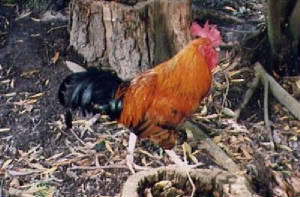
At the start
Our initial interest in poultry was sparked by
a well meaning friend who generously presented is with a Welsummer X rooster we named Basil.
We bought our first hens from the Dandenong
Market and had no idea what to look for. I was continually outbidded by other buyers so in the end,
desperate to come home with anything, I purchased both of the two last pens left. One pen contained 6 white chooks,
and the other, although I didn't realise at the time, contained 4 black australorps.
Basil turned out to be an 'attack rooster'!
He was a mongrel. I had gashes on my thighs from his spurs which we had removed. Egg collection involved going
into the coop with a leaf rake and a laundry basket, defending yourself with the rake while managing to cover the rooster
with the laundry basket. Collect the eggs, flick the laundry basket off the rooster while trying to make it through
the gate before he had a chance to fly at you once again.
One afternoon after free ranging, Basil came
home with green paint on his chest. It turned out the next door neighbour was attacked by him while painting his pergola
posts in the crouching position. Apparently he felt something move behind him and as he turned, the rooster flew
right at his face. All he had to defend himself was his loaded paintbrush in hand.
That rooster's life was on the line for a long time.
Someone once announced that the only reason he attacked was because he knew people were afraid of him. That
was until that very same person was attacked whilst filling up his water container with the watering can. After
swinging the watering can at him 3 or 4 times, they still came off second best with scaped legs and a broken watering can.
Even then, he didn't give up until they got through the gate. The watering can by then, needless to say, was no longer
serviceable.
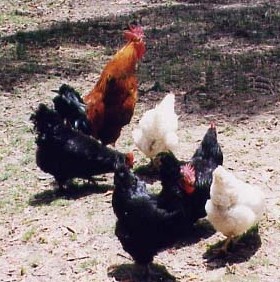
Even so, we were really keen to breed some chickens
so perservered with him for over a year. During this time, not one of our hens became broody. We
bought some silkies to use as broodies, but they were very young and a long way off point of lay. We eventually rented
an incubator and hatched some chickens in this way. Out of 40 eggs set, 23 hatched, we had 4 DIS (dead in shells)
and quite a few eggs were either unfertilised or failed to develop further than the first week or so.
We finally had our chickens, so Basil, who was proving
to be such a nuisance, got taken away by a local guy who collects excess roosters and other unwanted livestock.
From the chickens we hatched, we got some beautiful
colour combinations. White, red and black, all with different degrees of lacing around their collar, or speckles in
their plumage. Of the 23 that hatched, 13 turned out to be roosters which we also surrendered to the above 'rooster
man'.
We did eventually manage to hatch some chickens
naturally as one of our incubator bred birds became broody and hatched a batch of bantam eggs provided by an acquaintance. We
ended up with 8 chickens of all different shapes and colours. Once again, we gave half of them to the rooster
man. Over the following 2 years, we lost almost our entire flock to a combination of foxes, marek's disease, coccidiosis
and our favorite one to heat stress.
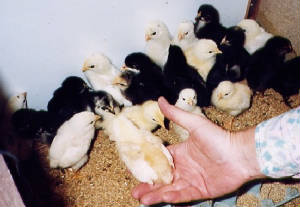
|
| Our first brood of mixed bred chickens |
We were left with 2 hens and so decided
that our flock needed an overhaul. After researching breeds, we decided upon australorps and proceeded to buy the
weekly times and every add for poultry for about 6 months. Finally we sourced a rooster from a bloke in Elphinstone, west
of Melbourne, and met him half way to carry out the sale. This is how we came to get 'Russell Crowe' who arrived
in a wooden fruit crate after several hours of travel. Already 3 years old, Russell had once been a show bird but was past his prime and destined for the table.
Huge, with glossy black green plumage and not a mean streak in his body, he was a welcome addition to our newly founded
venture.
Over the following year and a half, we were still
unable to source any purebred females and finally gave up searching following the birth of our first child, and gave
our last remaining chooks, including Russell to our neighbour and friend.
Upon moving to Tamandco Farm, we inherited with the property a Rhode
Island Red rooster named Andrew, 3 Isa Brown hens and one Rhode Island Red hen. The
unique design of the chicken coop which included a chute and a sliding trapdoor, allowed most of the maintenance to be
carried out without having to enter the compound at all. The nesting boxes mounted to the outside of the hen
house, have a flip top which enables easy egg collection. The vegetable garden is sited directly alongside the run,
allowing access to the chooks for clearing in between seasons via another trapdoor that can fastened, opened or closed.
There is also a very small but useful feed room directly adjacent to the hen house and a hay shed and wood shed directly behind.
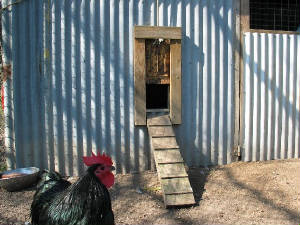
We replaced 'Andrew' with our old Australorp 'Russell Crowe' who had been
staying with a neighbour from our previous home. Jan agreed to swap the roosters over and she took Andrew instead.
This time round, I was super determined to source those quality australorp
breeding hens so joined the 'Australorp Club of Australia'. Through their membership list, I managed to track down a
breeder in Melbourne willing to sell me 4 pullets of exceptional breeding. After
a substantial wait, they finally came into lay and I collected eggs for the incubator. 15 of these hatched, 2 undersized
chickens died. The rest thrived and when they reached the age of 6 weeks, we transfered them to the main chicken coop.
3 days later, the fox got the lot, rooster, pullets and chickens. Every single australorp was dead and I had nothing
to carry on the bloodlines with.
The day prior I'd sold a dozen eggs for the purpose of eating so in an
attempt to salvage anything, I retrieved the eggs and placed them in the incubator. Unfortunately, none of these hatched
and I can only assume that they had been placed in the fridge whilst in the other people's possession.
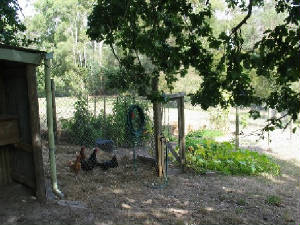
|
| Chicken coop, side view showing the run and trap door into vegie garden |
Since then, we have successfully managed to replenish our breeding stock
including our Champion winning Australorp cock bird, with our first years progeny currently being exhibited. Pullets
both young and point of lay, are periodically available for sale both privately and at auction. We also breed
and exhibit Silkies and Araucanas and have available for sale, show and pet quality pullets and cockerels, as well as
limited quantities of fertile eggs seasonally available.
|

